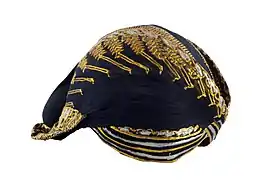Blangkon
A blangkon (Javanese: ꦧ꧀ꦭꦁꦏꦺꦴꦤ꧀) or belangkon (in Indonesian) is a traditional Javanese headgear worn by men and made of batik fabric. There are four types of blangkons, distinguished by the shapes and regional Javanese origin: Ngayogyakarta, Surakarta, Kedu, and Banyumasan.
 A Ngayogyakarta-style blangkon, worn for weddings | |
| Type | Traditional headgear |
|---|---|
| Material | Batik |
| Place of origin | Indonesia (Java) |
| Manufacturer | Javanese |

History
It is believed that blangkon may be as old as the Javanese script, and inspired from the legendary story of Aji Saka. In the story, Aji Saka defeated Dewata Cengkar, a giant who owned the land of Java, by spreading a giant piece of headdress that could cover the entire land of Java. Aji Saka was also believed to be the founder of the Javanese calendar.
Another theory is that the use of blangkon was adopted by the Javanese due to the combined influence of local Hindu and Islamic culture. The Muslim traders who entered Java were people from various places including mainland Arab and Gujarati regions, and the blangkon is sometimes believed to be adapted from turbans; however, this is unlikely because the story of Aji Saka itself predates the arrival of Islam in Java.
Gallery
 The Javanese traditional attire for men is always worn with the Blangkon and accompanied by a Kris
The Javanese traditional attire for men is always worn with the Blangkon and accompanied by a Kris Man wearing a tied version of blangkon
Man wearing a tied version of blangkon Fifth Indonesian President Megawati and her family
Fifth Indonesian President Megawati and her family Raden Saleh, a famous Indonesian painter in the colonial era
Raden Saleh, a famous Indonesian painter in the colonial era Ngayogyakarta-style blangkon
Ngayogyakarta-style blangkon_Probolinggo_TMnr_10001910.jpg.webp) Colonial young man wearing blangkon
Colonial young man wearing blangkon